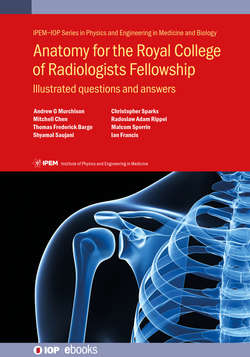Читать книгу Anatomy for the Royal College of Radiologists Fellowship - Malcolm Sperrin - Страница 6
На сайте Литреса книга снята с продажи.
Preface
ОглавлениеStudying for the anatomy exam is tough but worthwhile, as a good understanding of anatomy forms a key part of the day-to-day life of a radiologist. Whilst you will previously have studied anatomy at medical school or in some cases for surgical exams, you have to approach radiological anatomy in a slightly different way, as it requires you to visualise three-dimensional structures on two-dimensional images. It is also important to be able to recognise structures on the range of imaging modalities that you will encounter in clinical practice, including plain radiographs, ultrasound, fluoroscopy and cross-sectional studies.
We have written this book to try to make the process of learning anatomy as smooth as possible, by providing you with a resource to test your progress and provide advice for revision and sitting the examination. We have written the book specifically with the Royal College of Radiologists Part 1 examination in mind, although the questions and comments are more broadly applicable to other radiology anatomy examinations. We were prompted to write this book because, when we sat the examination ourselves in the past two years, we noticed that some resources featuring exam-style questions were below the level of difficulty that we experienced. We wanted to prepare a text that reflected some of the more difficult questions that you may encounter. Don’t be discouraged as you go through the book if you find it particularly challenging–the exam will have a mix of straightforward and difficult questions!
The main difference between our questions and the examination is that the FRCR Part 1 will only have one question per image. We have chosen to test five structures on each image, as we felt this would be a more efficient way to give you as much practice as possible as you work through the book. It also emphasises the point that the structures that you are asked to identify in the exam may be at the periphery of an image, or may be shown from a slightly unusual perspective.
In addition to the questions and answers, we have written comments sections designed to provide further clarification on why we gave certain answers where there might be ambiguity. These sections also describe the anatomy depicted in the questions, to help you to understand how the structures relate to each other and assist with problem-solving in the exam. You will also notice words highlighted in bold–these are structures that we feel could legitimately be examined, and that we would advise you to be able to recognise (although not necessarily on the image provided). The exam tips are taken from our experiences, and include advice we were given during preparation for the Part 1, and reflections from our own experience.
Although we have made every effort to make sure we have been as accurate as possible, the text may still contain mistakes, so please do not rely on this book for clinical decision making. If you do notice any mistakes, we would be grateful to receive your feedback, so that we can improve any future editions of the book. Finally, we would advise that you read the guidance provided on the Royal College of Radiologists website, particularly in case any changes in format or content have arisen since the publication of this book.
Thanks for reading, and good luck!
